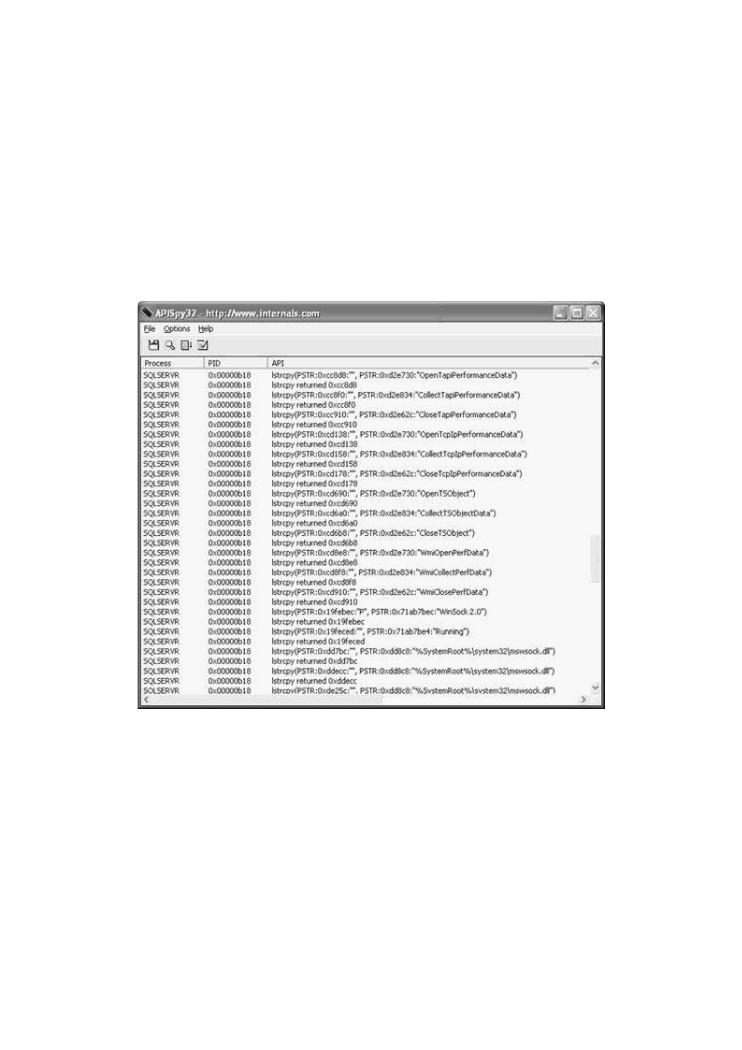
- •Exploiting Software How to Break Code
- •Table of Contents
- •Copyright
- •Praise for Exploiting Software
- •Attack Patterns
- •Foreword
- •Preface
- •What This Book Is About
- •How to Use This Book
- •But Isn't This Too Dangerous?
- •Acknowledgments
- •Greg's Acknowledgments
- •Gary's Acknowledgments
- •Bad Software Is Ubiquitous
- •The Trinity of Trouble
- •The Future of Software
- •What Is Software Security?
- •Conclusion
- •Chapter 2. Attack Patterns
- •A Taxonomy
- •An Open-Systems View
- •Tour of an Exploit
- •Attack Patterns: Blueprints for Disaster
- •An Example Exploit: Microsoft's Broken C++ Compiler
- •Applying Attack Patterns
- •Attack Pattern Boxes
- •Conclusion
- •Into the House of Logic
- •Should Reverse Engineering Be Illegal?
- •Reverse Engineering Tools and Concepts
- •Approaches to Reverse Engineering
- •Methods of the Reverser
- •Writing Interactive Disassembler (IDA) Plugins
- •Decompiling and Disassembling Software
- •Decompilation in Practice: Reversing helpctr.exe
- •Automatic, Bulk Auditing for Vulnerabilities
- •Writing Your Own Cracking Tools
- •Building a Basic Code Coverage Tool
- •Conclusion
- •Chapter 4. Exploiting Server Software
- •The Trusted Input Problem
- •The Privilege Escalation Problem
- •Finding Injection Points
- •Input Path Tracing
- •Exploiting Trust through Configuration
- •Specific Techniques and Attacks for Server Software
- •Conclusion
- •Chapter 5. Exploiting Client Software
- •Client-side Programs as Attack Targets
- •In-band Signals
- •Cross-site Scripting (XSS)
- •Client Scripts and Malicious Code
- •Content-Based Attacks
- •Conclusion
- •Chapter 6. Crafting (Malicious) Input
- •The Defender's Dilemma
- •Intrusion Detection (Not)
- •Partition Analysis
- •Tracing Code
- •Reversing Parser Code
- •Misclassification
- •Audit Poisoning
- •Conclusion
- •Chapter 7. Buffer Overflow
- •Buffer Overflow 101
- •Injection Vectors: Input Rides Again
- •Buffer Overflows and Embedded Systems
- •Database Buffer Overflows
- •Buffer Overflows and Java?!
- •Content-Based Buffer Overflow
- •Audit Truncation and Filters with Buffer Overflow
- •Causing Overflow with Environment Variables
- •The Multiple Operation Problem
- •Finding Potential Buffer Overflows
- •Stack Overflow
- •Arithmetic Errors in Memory Management
- •Format String Vulnerabilities
- •Heap Overflows
- •Buffer Overflows and C++
- •Payloads
- •Payloads on RISC Architectures
- •Multiplatform Payloads
- •Prolog/Epilog Code to Protect Functions
- •Conclusion
- •Chapter 8. Rootkits
- •Subversive Programs
- •A Simple Windows XP Kernel Rootkit
- •Call Hooking
- •Trojan Executable Redirection
- •Hiding Files and Directories
- •Patching Binary Code
- •The Hardware Virus
- •Low-Level Disk Access
- •Adding Network Support to a Driver
- •Interrupts
- •Key Logging
- •Advanced Rootkit Topics
- •Conclusion
- •References
- •Index

Methods of the Reverser
There are several methods that can be used while reverse engineering software. Each has benefits and each has resource and time requirements. A typical approach uses a mixture of methods when decompiling and examining software. The best method mix depends entirely
• |
Table of Contents |
on your goals. For example, you may first want to run a quick scan of the code for obvious |
|
• |
Index |
vulnerabilities. Next, you may want to perform a detailed input trace on the user-supplied
Exploitingdata. YouSoftwaremay notHowhaveto BreaktimeCodeto trace each and every path, so you may use complex
breakpoints and other tools to speed up the process. What follows is a brief description of
ByGreg Hoglund,Gary McGraw several basic methods.
Publisher: Addison Wesley
Pub Date: February 17, 2004
Tracing Input
ISBN: 0-201-78695-8
Pages: 512
Input tracing is the most thorough of all methods. First you identify the input points in the code. Input points are places where user-supplied data are being delivered to the program. For example, a call to WSARecvFrom() will retrieve a network packet. This call, in essence, accepts user-supplied data from the network and places it in a buffer. You can set a
breakpoint on the input point and single-step trace into the program. Of course, your How does software break? How do attackers make software break on purpose? Why are
debugging tools should always include a pencil and paper. You must note each twist and turn firewalls, intrusion detection systems, and antivirus software not keeping out the bad guys?
in the code path. This approach is very tedious, but it is also very comprehensive. What tools can be used to break software? This book provides the answers.
Although determining all input points takes a great deal of time if you do it by hand, you Exploiting Softwareis loaded with examples of real attacks, attack patterns, tools, and
have the opportunity to note every single code location that makes decisions based on usertechniques used by bad guys to break software. If you want to protect your software from
supplied data. Using this method you can find very complex problems. attack, you must first learn how real attacks are really carried out.
One language that protects against this kind of "look through the inputs" attack is Perl. Perl This must-have book may shock you—and it will certainly educate you.Getting beyond the
has a special security mode called taint mode. Taint mode uses a combination of static and script kiddie treatment found in many hacking books, you will learn about
dynamic checks to monitor all information that comes from outside a program (such as user
input, program arguments, and environment variables) and issues warnings when the
program attempts to do something potentially dangerous with that untrusted information. Why software exploit will continue to be a serious problem
Consider the following script:
 When network security mechanisms do not work
When network security mechanisms do not work
 Attack patterns
Attack patterns
 Reverse engineering
Reverse engineering
 Classic attacks against server software
Classic attacks against server software
 Surprising attacks against client software
Surprising attacks against client software
#!/usr/bin/perl -T
 Techniques for crafting malicious input
Techniques for crafting malicious input
$username = <STDIN>;
The technical details of buffer overflows
chop $username;
Rootkits
systemExploiting("catSoftwa/usr/stats/eis filled$withusername");the tools, concepts, and knowledge necessary to break
software.
On executing this script, Perl enters taint mode because of the –T option passed in the
invocation line at the top. Perl then tries to compile the program. Taint mode will notice that
the programmer has not explicitly initialized the PATH variable, yet tries to invoke a program
using the shell anyway, which can easily be exploited. It issues an error such as the following
before aborting compilation:

•Table of Contents
Insecure $ENV{PATH} while running with -T switch at
• Index
Exploiting Software How to Break Code
./catform.pl line 4, <STDIN> chunk 1.
ByGreg Hoglund,Gary McGraw
Publisher: Addison Wesley
Pub Date: February 17, 2004
We canISBN:modify0-201the-78695script-8 to set the program's path explicitly to some safe value at startup:
Pages: 512
How does software break? How do attackers make software break on purpose? Why are firewalls, intrusion detection systems, and antivirus software not keeping out the bad guys? What tools can be used to break software? This book provides the answers.
#!/usr/bin/perl -T
Exploiting Softwareis loaded with examples of real attacks, attack patterns, tools, and
techniques used by bad guys to break software. If you want to protect your software from
use strict;
attack, you must first learn how real attacks are really carried out.
$ENV{PATH} = join ':' => split (" ",<< '__EOPATH__');
This must-have book may shock you—and it will certainly educate you.Getting beyond the
script kiddie treatment found in many hacking books, you will learn about
/usr/bin
/binWhy software exploit will continue to be a serious problem
When network security mechanisms do not work
__EOPATH__
Attack patterns
my $username = <STDIN>;
 Reverse engineering chop $username;
Reverse engineering chop $username;
 Classic attacks against server software system ("cat /usr/stats/$username");
Classic attacks against server software system ("cat /usr/stats/$username");
 Surprising attacks against client software
Surprising attacks against client software
 Techniques for crafting malicious input
Techniques for crafting malicious input
Taint mode now determines that the $username variable is externally controlled and is not to The technical details of buffer overflows
be trusted. It determines that, because $username may be poisoned, the call to system may be poisonedRootkits. It thus gives an other error:
Exploiting Softwareis filled with the tools, concepts, and knowledge necessary to break
software.
Insecure dependency in system while running with

-T switch at ./catform.pl line 9, <STDIN> chunk 1.
Even if we were to copy $username into another variable, taint mode would still catch the
problem.
•Table of Contents
In the previous example, taint mode complains because the variable can use shell magic to
• Index
cause a command to run. But taint mode does not address every possible input vulnerability,
Exploiting Software How to Break Code
so a clever attacker using our input-driven method can still win.
ByGreg Hoglund,Gary McGraw
Advanced dataflow analysis is also useful to help protect against our attack method (or to
help carry it out). Static analysis tools can help an analyst (or an attacker) identify all
Publisher: Addison Wesley
possible input points and to determine which variables are affected from the outside. The security research literature is filled with references discussing "secure information flow" that
take advantage of data flow analysis to determine program safety.
Pages: 512
Exploiting Version Differences
When you study a system to find weaknesses, remember that the software vendor fixes many How does software break? How do attackers make software break on purpose? Why are
bugs in each version release. In some cases the vendor may supply a "hot fix" or a patch that firewalls, intrusion detection systems, and antivirus software not keeping out the bad guys?
updates the system binaries. It is extremely important to watch the differences between What tools can be used to break software? This book provides the answers.
software versions.
Exploiting Softwareis loaded with examples of real attacks, attack patterns, tools, and
The differences between versions are, in essence, attack maps. If a new version of the techniques used by bad guys to break software. If you want to protect your software from
software or protocol specification is available, then weaknesses or bugs will most certainly attack, you must first learn how real attacks are really carried out.
have been fixed (if they have been discovered). Even if the "bug fix" list is not published, you
can compare the binary files of the older version against the new. Differences can be This must-have book may shock you—and it will certainly educate you.Getting beyond the
uncovered where features have been added or bugs have been fixed. These differences script kiddie treatment found in many hacking books, you will learn about
thereby reveal important hints regarding where to look for vulnerabilities.
 Why software exploit will continue to be a serious problem
Why software exploit will continue to be a serious problem
Making Use of Code Coverage
When network security mechanisms do not work
CrackingAttackcomputerpatterns system is a scientific process just as much as it is an art. In fact, wielding the scientific method gives the attacker an upper hand in an otherwise arbitrary
Reversescientificgineering
game. The method starts with measurement. Without the ability to measure your
environment, how can you possibly draw conclusions about it? Most of the approaches we
Classic attacks against server software
consider in this text are designed to find programming flaws. Usually (not always), the bugs
we find this way are confined to small regions of code. In other words, it's usually the small
Surprising attacks against client software
coding mistakes that we are after. This is one reason that new development tools are very
likely to hamper many of the traditional methods of attack. It's easy for a development tool
 Techniques for crafting malicious input
Techniques for crafting malicious input
to identify a simple programming error (statically) and compile it out. In a few years, buffer
overflows will be obsolete as an attack method.  The technical details of buffer overflows
The technical details of buffer overflows
All the techniques we describe are a form of measurement. We observe the behavior of the
Rootkits
program while it is exercised in some way (for example, placed under stress). Strange
behavior usually indicates unstable code. Unstable code has a high probability of security Exploiting Softwareis filled with the tools, concepts, and knowledge necessary to break
weaknesses. Measurement is the key. software.
Code coverage is an important type of measurement—perhaps the most important. Code coverage is a way of watching a program execute and determining which code paths have been exercised. Many tools are available for code coverage analysis. Code coverage tools do not always require source code. Some tools can attach to a process and gather measurements in real time. For one example, check out the University of Maryland's tool dyninstAPI (created by Jeff Hollingsworth).[7]
[7] The dyninstAPI tool can be found at http://www.dyninst.org/.

As an attacker, code coverage tells you how much work is left to do when you're surveying the landscape. By using coverage analysis you can immediately learn what you have missed. Computer programs are complex, and cracking them is tedious business. It's human nature to skip parts of the code and take shortcuts. Code coverage can show you whether you have missed something. If you skipped that subroutine because it looked harmless, well think again! Code coverage can help you go back and check your work, walking down those dark alleys you missed the first time.
•Table of Contents
If• you are tryingIndexto crack software, you most likely start with the user input point. As an example,E ploiting SoftwareconsiderHowa callto Breakto WSARecv()Code .[8] Using outside-in tracing, you can measure the code
paths that are visited. Many decisions are made by the code after user input is accepted.
ByGreg Hoglund,Gary McGraw
These decisions are implemented as branching statements, such as the conditional branch
statements JNZ and JE, in x86 machine code. A code coverage tool can detect when a branch
Publisher: Addison Wesley
is about to occur and can build a map of each continuous block of machine code. What this
Pub Date: February 17, 2004
means is that you, as the attacker, can instantly determine which code paths you have not exercisedISBN:during0-201-78695your-8analysis.
Pages: 512
[8] The WSARecv function receives data from a connected socket. See
http://msdn.microsoft.com/library/default.asp?url=/library/en-us/winsock/winsock/wsarecv_2.asp.
Reverse engineers know that their work is long and tedious. Using code coverage gives the
clever reverse engineer a map for tracking progress. Such tracking can keep you sane and
How does software break? How do attackers make software break on purpose? Why are can also keep you going when you otherwise might give up without exploring all
firewalls, intrusion detection systems, and antivirus software not keeping out the bad guys? opportunities.
What tools can be used to break software? This book provides the answers.
Code coverage is such an important tool for your bag of tricks that later in the chapter we
Exploiting Softwareis loaded with examples of real attacks, attack patterns, tools, and illustrate how you can build a code coverage tool from scratch. In our example we focus on
techniques used by bad guys to break software. If you want to protect your software from the x86 assembly language and the Windows XP OS. Our experience leads us to believe that
attack, you must first learn how real attacks are really carried out.
it will be hard for you to find the perfect code coverage tool for your exact needs. Many of the
available tools, commercial or otherwise, lack attack-style features and data visualization
This must-have book may shock you—and it will certainly educate you.Getting beyond the methods that are important to the attacker.
script kiddie treatment found in many hacking books, you will learn about
AccessingWhy softwaretheexploitKernelwill continue to be a serious problem
 When network security mechanisms do not work
When network security mechanisms do not work
Poor access controls on handles opened by drivers can expose a system to attack. If you find
a device driver with an unprotected handle, you might be able to run IOCTL commands to the
 Attack patterns
Attack patterns
kernel driver. Depending on what the driver supports, you might be able to crash the
machine or gain access to the kernel. Any input to the driver that includes memory addresses Reverse engineering
should be immediately tested by inserting NULL values. Another option is to insert addresses
that map to kernel memory. If the driver doesn't perform sanity checking on the user-mode- Classic attacks against server software
supplied values, kernel memory may get malformed. If the attack is very clever, global state in theSurprisingkernel mayattacksbe modified,againstalteringclient softwareaccess permissions.
 Techniques for crafting malicious input
Techniques for crafting malicious input
Leaking Data in Shared Buffers
The technical details of buffer overflows
SharingRootkitsbuffers is somewhat like sharing food. A restaurant (hopefully) maintains strict rules about where raw meat can be placed. A little raw juice in someone's cooked meal could lead
Exploiting Softwareis filled with the tools, concepts, and knowledge necessary to break to illness and lawsuit. A typical program has many buffers. Programs tend to reuse the
sameoftware.
buffers over and over, but the questions from our perspective are the following: Will they be cleaned? Are dirty data kept from clean data? Buffers are a great place to start looking for potential data leakage. Any buffer that is used for both public and private data has a potential to leak information.
Attacks that cause state corruption and/or race conditions may be used to cause private data to leak into public data. Any use of a buffer without cleaning the data between uses leads to potential leaks.

Example: The Ethernet Scrubbing Problem
One of us (Hoglund) codiscovered a vulnerability a few years ago that affects potentially millions of ethernet cards worldwide.[9] Ethernet cards use standard chip sets to connect to the network. These chips are truly the "tires" of the Internet. The problem is that many of these chips are leaking data across packets.
• |
[9] |
Table of Contents |
|
|
This vulnerability was later released independently as the "Etherleak vulnerability." Go to |
•http://archivesIndex.neohapsis.com/archives/vulnwatch/2003-q1/0016.html for more information.
Exploiting Software How to Break Code
The problem exists because data are stored in a buffer on the ethernet microchip. The
ByGreg Hoglund,Gary McGraw
minimum amount of data that must be sent in an ethernet packet is 66 bytes. This is the
minimum frame size. But, many packets that need to be transmitted are actually much
Publisher: Addison Wesley
smaller than 66 bytes. Examples include small ping packets and ARP requests. Thus, these
smallPubpacketsDate: Februaryare padded17, 2004 with data to meet the minimum number of 66 bytes.
ISBN: 0-201-78695-8
The problem? Many chips do not clean their buffers between packets. Thus, a small packet
Pages: 512
will be padded with whatever was left in the buffer from the last packet. This means that
other people's packets are leaking into a potential attack packet. This attack is simple to
exploit and the attack works over switched environments. An attack can craft a volley of
small packets that solicit a small packet as a reply. As the small reply packets arrive, the
attacker looks at the padding data to see other people's packet data.
How does software break? How do attackers make software break on purpose? Why are
firewalls, intrusion detection systems, and antivirus software not keeping out the bad guys? Of course, some data are lost in this attack, because the first part of every packet is
What tools can be used to break software? This book provides the answers.
overwritten with the legitimate data for the reply. So, the attacker will naturally want to craft
as small a packet as possible to siphon the data stream. Ping packets work well for these
Exploiting Softwareis loaded with examples of real attacks, attack patterns, tools, and purposes, and allow an attacker to sniff cleartext passwords and even parts of encryption
techniques used by bad guys to break software. If you want to protect your software from keys. ARP packets are even smaller, but will not work as a remote attack. Using ARP packets,
attack, you must first learn how real attacks are really carried out.
an attacker can get TCP ACK numbers from other sessions in the response. This aids in a
standard TCP/IP hijacking attack.[10]
This must-have book may shock you—and it will certainly educate you.Getting beyond the
script[10]kiddie treatment found in many hacking books, you will learn about
See Firewalls and Internet Security [Cheswick et al., 2003] for more on TCP/IP hijacking.
 Why software exploit will continue to be a serious problem
Why software exploit will continue to be a serious problem
Auditing for Access Requirement Screwups
 When network security mechanisms do not work
When network security mechanisms do not work
Lack of planning or laziness on the part of software engineers often leads to programs that
Attack patterns [11]
require administrator or root access to operate. Many programs that were upgraded from
older Windows environments to work on Win2K and Windows XP usually require full access to
 Reverse engineering
Reverse engineering
the system. This would be OK except that programs that operate this way tend to leave a lot
of world-accessible files sitting around.  Classic attacks against server software
Classic attacks against server software
[11] To learn more about this common problem and how to avoid it, see Building Secure Software [Viega
 Surprising attacks against client software and McGraw, 2001].
Surprising attacks against client software and McGraw, 2001].
Techniques for crafting malicious input
Look for directories where user data files are being stored. Ask yourself, are these directories
storing sensitive data as well? If so, is the directory permission weak? This applies to the NT
The technical details of buffer overflows
registry and to database operations as well. If an attacker replaces a DLL or changes the
settings for a program, the attacker might be able to elevate access and take over a system.
 Rootkits
Rootkits
Under Windows NT, look for open calls that request or create resources with no access
restrictions. Excessive access requirements lead to insecure file and object permissions. Exploiting Softwareis filled with the tools, concepts, and knowledge necessary to break
software.
Using Your API Resources
Many system calls are known to lead to potential vulnerabilities [Viega and McGraw, 2001]. One good method of attack when reversing is to look for known calls that are problematic (including, for example, the much maligned strcpy()). Fortunately, there are tools that can help.[12]

[12] Cigital maintains a database of static analysis rules pertaining to security. There are more than 550 entries for C and C++ alone. Static analysis tools use this information to uncover potential vulnerabilities in software (an approach that works as well for software exploit as it does for software improvement).
Figure 3-3 includes a screenshot that shows APISPY32 capturing all calls to strcpy on a target system. We used the APISPY32 tool to capture a series of lstrcpy calls from Microsoft SQL server. Not all calls to strcpy are going to be vulnerable to buffer overflow, but some will.
•Table of Contents
•Index
Exploiting Software How to Break Code
Figure 3-3. APISPY32 can be used to find lstrcpy() calls in the SQL
ByGreg Hoglund,Gary McGraw
server code. This screenshot shows the results of one query.
Publisher: Addison Wesley
Pub Date: February 17, 2004
[View full size image]
ISBN
Pages
How does |
are |
firewalls, |
guys? |
What tools |
|
Exploiting |
and |
techniques |
from |
attack, |
|
This must |
the |
script kiddie |
|
Why |
|
When |
|
Attack |
|
Classic |
|
Surprising attacks against client software |
|
Techniques for crafting malicious input
APISPY is very easy to set up. You can download the program from www.internals.com. You
must make a special file called APISpy32.api and place it in the WINNT or WINDOWS
The technical details of buffer overflows
directory. For this example, we use the following configuration file settings:
 Rootkits
Rootkits
Exploiting Softwareis filled with the tools, concepts, and knowledge necessary to break
software.
KERNEL32.DLL:lstrcpy(PSTR, PSTR)
KERNEL32.DLL:lstrcpyA(PSTR, PSTR)

KERNEL32.DLL:lstrcat(PSTR, PSTR)
KERNEL32.DLL:lstrcatA(PSTR, PSTR)
WSOCK32.DLL:recv
WS2_32.DLL:recv
•Table of Contents
ADVAPI32.DLL:SetSecurityDescriptorDACL(DWORD, DWORD, DWORD, DWORD)
•Index
Exploiting Software How to Break Code
ByGreg Hoglund,Gary McGraw
ThisPublisher:sets APISPYAddisontoWesleylook for some function calls that we are interested in. While testing, it is
extremely useful to hook potentially vulnerable API calls, as well as any calls that take user
Pub Date: February 17, 2004
input. In between the two comes your reverse engineering task. If you can determine that
ISBN: 0-201-78695-8
data from the input side reaches the vulnerable API call, you have found yourself a way in.
Pages: 512
How does software break? How do attackers make software break on purpose? Why are firewalls, intrusion detection systems, and antivirus software not keeping out the bad guys? What tools can be used to break software? This book provides the answers.
Exploiting Softwareis loaded with examples of real attacks, attack patterns, tools, and techniques used by bad guys to break software. If you want to protect your software from attack, you must first learn how real attacks are really carried out.
This must-have book may shock you—and it will certainly educate you.Getting beyond the script kiddie treatment found in many hacking books, you will learn about
 Why software exploit will continue to be a serious problem
Why software exploit will continue to be a serious problem
 When network security mechanisms do not work
When network security mechanisms do not work
 Attack patterns
Attack patterns
 Reverse engineering
Reverse engineering
 Classic attacks against server software
Classic attacks against server software
 Surprising attacks against client software
Surprising attacks against client software
 Techniques for crafting malicious input
Techniques for crafting malicious input
 The technical details of buffer overflows
The technical details of buffer overflows
 Rootkits
Rootkits
Exploiting Softwareis filled with the tools, concepts, and knowledge necessary to break
software.
